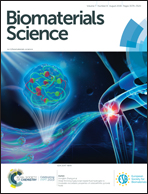Probing cell–nanoparticle (cubosome) interactions at the endothelial interface: do tissue dimension and flow matter?†
Abstract
In the research field of nanostructured systems for biomedical applications, increasing attention has been paid to using biomimetic, dynamic cellular models to adequately predict their bio-nano behaviours. This work specifically evaluates the biointeractions of nanostructured lipid-based particles (cubosomes) with human vascular cells from the aspects of tissue dimension (conventional 2D well plate versus 3D dynamic tubular vasculature) and shear flow effect (static, venous and arterial flow-mimicking conditions). A glass capillary-hosted, 3D tubular endothelial construct was coupled with circulating luminal fluid flow to simulate the human vascular systems. In the absence of fluid flow, the degree of cell–cubosome association was not significantly different between the 2D planar and the 3D tubular systems. Under flow conditions simulating venous (0.8 dynes per cm2) and arterial (10 dynes per cm2) shear stresses, the cell–cubosome association notably declined by 50% and 98%, respectively. This highlights the significance of shear-guided biointeractions of non-targeted nanoparticles in the circulation. Across all 2D and 3D cellular models with and without flow, cubosomes had little effect on the cell–cell contact based on the unchanged immunoexpression of the endothelial-specific intercellular junction marker PECAM-1. Interestingly, there were dissimilar nanoparticle distribution patterns between the 2D planar (showing discrete punctate staining) and the 3D tubular endothelium (with a more diffused, patchy fashion). Taken together, these findings highlight the importance of tissue dimension and shear flow in governing the magnitude and feature of cell–nanoparticle interactions.



 Please wait while we load your content...
Please wait while we load your content...